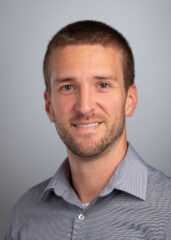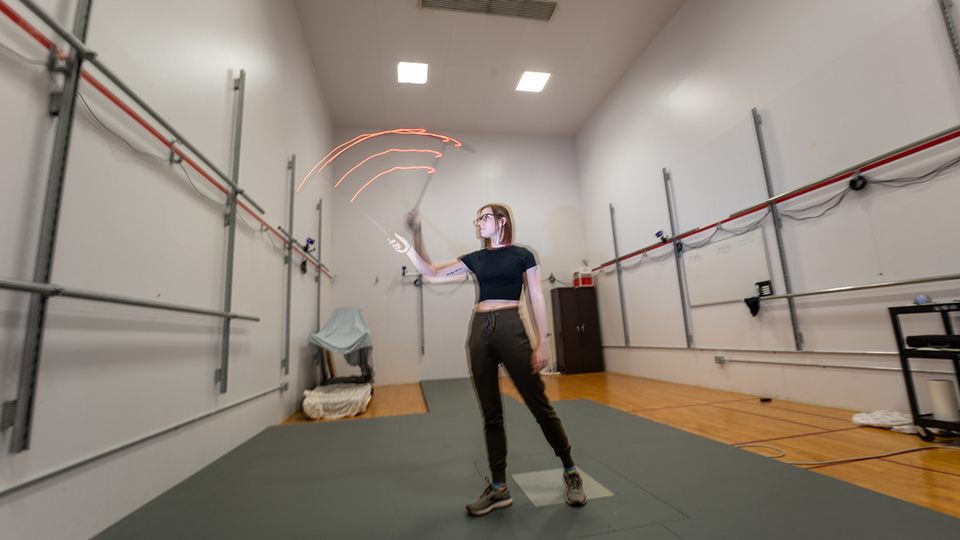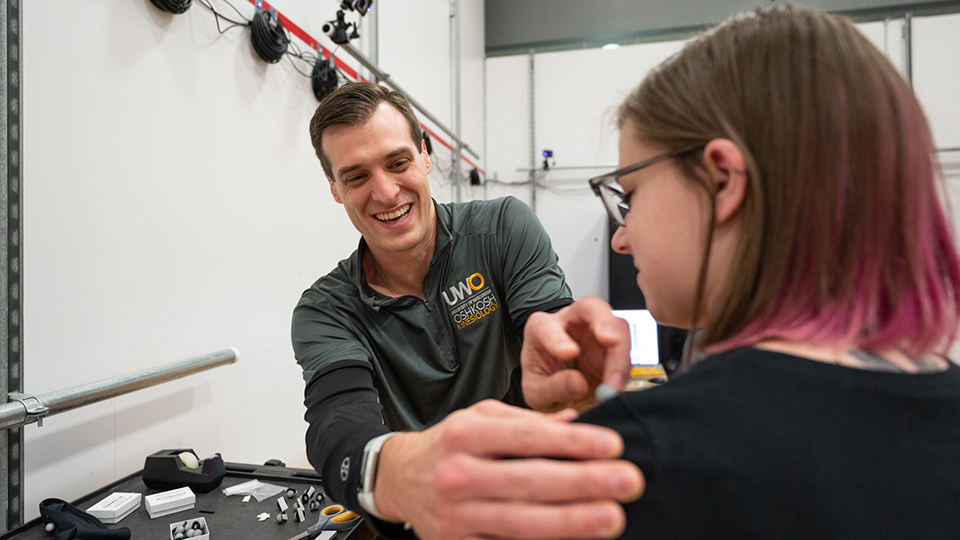Kevin Biese, assistant kinesiology professor and graduate student Abby Godejohn ’22, prepare to use motion capture markers in one of the rooms that make up the new Sport Performance and Injury Research Lab at UW Oshkosh.
The kinesiology and athletic training department at the University of Wisconsin Oshkosh is taking its research game to the next level.
With the launch of the new Sport Performance and Injury Research Lab (SPIRL), the UW Oshkosh kinesiology team has expanded research possibilities for both faculty and students. Its mission is to enhance the knowledge of appropriate sports training and sports-related injury risk, prevention and recovery through education, community involvement, and the publication and presentation of research.

Kyle Petit
The endeavor is led by two newcomers to the kinesiology faculty this past fall: assistant professors Kevin Biese and Kyle Petit ’14.
“The department was very excited to have these two new faculty joining our existing faculty this year,” said Robert Sipes, kinesiology and athletic training department chair. “They have come in with fresh new ideas, enthusiasm and a drive to streamline the research output of our department.
“The SPIRL will be something that helps our faculty and students recruit research participants, disseminate research findings, and collaborate with other researchers within our department and outside.”
The SPIRL—which is pronounced spiral—exists as both a physical space and a branding opportunity. There are two key locations in Albee Hall, already home to the kinesiology department, to conduct research. One is a motion capture lab for the study of body movement. The other is a quiet space for concussion assessments and includes different tools for neurocognitive testing. Together it’s a home base for their top research areas of sport-related concussions, youth sport specialization and injury biomechanics.
Petit said while he and Biese didn’t know each other before joining the faculty this fall, they both come with strong research backgrounds. Petit earned a doctoral degree from Michigan State University and Biese from UW-Madison.
With the support of their kinesiology colleagues, including Sipes, athletic training clinical education coordinator Kim Calvert, assistant professor Brian Wallace and lecturer Lace Luedke, they came up with a name to promote the research and have been working to grow the capabilities with technology and community connections.

Abby Godejohn, who earned a bachelor’s degree in December and is now a UWO graduate student, works to calibrate infrared cameras in part of the Sport Performance and Injury Research Lab in Albee Hall.
An important goal for the SPIRL is to give students opportunities that hadn’t been as readily available. Petit said students on a pre-medical track—including physical or occupational therapy—can bolster their resumes through research and their SPIRL work could be a distinguishing feature.
“I know when I was an undergrad student, research wasn’t really emphasized,” Petit said, “and it was kind of hard to find if you were a student interested in doing research, so we wanted to create this lab to give kinesiology students a place to go.”
Another goal of the lab is to increase community outreach. Faculty would like to build relationships with school athletics and other organizations to conduct baseline assessments and collect sports history information for athletes, for instance. Petit’s research often focuses on sport-related concussion evaluation techniques, treatments and management, and Biese’s areas of research interest include youth and collegiate athlete sport injury risk, youth and collegiate athlete injury risk reduction, and lower extremity injury risk. Both could benefit from building relationships outside of the University, and the SPIRL will help that cause.
“Many of our faculty in kinesiology complete research out in the community with projects that can impact the health and wellness of our community,” Sipes said. “The SPIRL will provide a stronger opportunity for community connection and will hopefully increase the visibility of the University in the process.”
Learn more:

